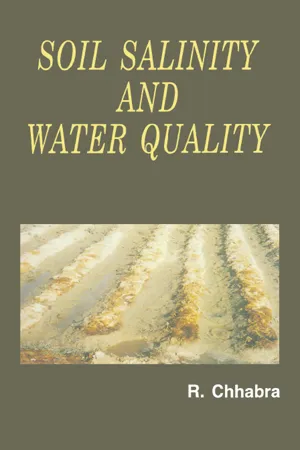
This is a test
- 300 pages
- English
- ePUB (mobile friendly)
- Available on iOS & Android
eBook - ePub
Soil Salinity and Water Quality
Book details
Book preview
Table of contents
Citations
About This Book
This volume covers such areas in the field of soil salinity and water quality as: origin and distribution of salt-affected soils; management of alkali soils; quality criteria of irrigation water; wastewaters as a source of irrigation; and grasses and trees in the management of salt-affected soils.
Frequently asked questions
At the moment all of our mobile-responsive ePub books are available to download via the app. Most of our PDFs are also available to download and we're working on making the final remaining ones downloadable now. Learn more here.
Both plans give you full access to the library and all of Perlego’s features. The only differences are the price and subscription period: With the annual plan you’ll save around 30% compared to 12 months on the monthly plan.
We are an online textbook subscription service, where you can get access to an entire online library for less than the price of a single book per month. With over 1 million books across 1000+ topics, we’ve got you covered! Learn more here.
Look out for the read-aloud symbol on your next book to see if you can listen to it. The read-aloud tool reads text aloud for you, highlighting the text as it is being read. You can pause it, speed it up and slow it down. Learn more here.
Yes, you can access Soil Salinity and Water Quality by R. Chhabra in PDF and/or ePUB format, as well as other popular books in Technology & Engineering & Civil Engineering. We have over one million books available in our catalogue for you to explore.
Information
1
Origin and Distribution of Salt-affected Soils
1.1. General Aspects
All soils contain some amount of soluble salts. Many of these salts act as a source of essential nutrients for the healthy growth of plants. However, when the quantity of the salts in the soil exceeds a particular value, the growth, yield, and/or quality of most crops is adversely affected, to a degree depending upon the kind and amount of salts present, the stage of growth, type of plant, and environmental factors. Thus, soil that contains excess salts so as to impair its productivity is called salt-affected soil.
Land is finite and the ever-increasing demand for its products has put this ecologically vulnerable resource under great stress. Whereas compulsions to expand crop area have brought arable farming to lands otherwise unsuitable for crop cultivation, intensive agriculture supported by irrigation has rendered many productive soils infertile. Continuous depletion of nutrients from soils, waterlogging, and secondary salinisation are some of the attendant problems threatening sustainability of crops in irrigated areas. Owing to these degradation processes, large areas of otherwise productive lands have already gone out of production or are producing sub-optimal yields. In many areas the problem is latent and could assume serious proportions if proper care is not taken to control the rise of water table upon the introduction of irrigation.
1.2. Impact of Salt-affected Soils
Salts not only decrease the agricultural production of most crops, but also, as a result of their effect on soil physicochemical properties, adversely affect the associated ecological balance of the area. Some of the harmful impacts of salts are:
a) low agricultural production;
b) soil erosion, by both water and wind, due to high dispersibility of soil and decrease in shear stress;
c) increase in floods due to higher runoff as a result of decreased permeability of soil;
d) low groundwater recharge;
e) change in marine life forms from fresh water to brackish water;
f) ecological imbalance due to change in plant cover from mesophytes to halophytes, from trees to bushes, etc.;
g) poor human health due to (1) toxic effect of elements such as F, B, and Se, and (2) frequent outbreak of malaria and other diseases;
h) low economic returns due to high cost of cultivation, decreased yields, and poor quality;
i) higher maintenance cost and short life of buildings, roads, dams, tubewells, and farm machinery, which get corroded by high salts and the specific effect of sodium and certain other elements.
1.3. Area of Saline and Alkali Soils
Exact information on area and degree of deterioration is not available for all countries, but a number of estimates have been made on a global basis. Dregne (1977) estimated that 2 and 2.1 billion ha were affected by salinisation and waterlogging, respectively. Massoud (1974) made an estimate of 932 million ha, of which 316 million ha are in developing countries. Balba (1980b) estimated from the desertification map of the world (FAO, 1977) that total area subjected to salinisation and sodification was about 600 million ...
Table of contents
- Cover
- Half Title
- Title Page
- Copyright Page
- Table of Contents
- FOREWORD
- PREFACE
- LIST OF ABBREVIATIONS
- Chapter 1. Origin and Distribution of Salt-affected Soils
- Chapter 2. Saline Soils and their Management
- Chapter 3. Alkali Soils
- Chapter 4. Management of Alkali Soils
- Chapter 5. Principles Governing Fertilisation of Salt-affected Soils
- Chapter 6. Irrigation Water: Quality Criteria
- Chapter 7. Wastewaters as a Source of Irrigation
- Chapter 8. Irrigation and Salinity Control
- Chapter 9. Grasses and Trees as Alternate Strategies for Management of Salt-affected Soils
- REFERENCES
- AUTHORS INDEX
- SUBJECT INDEX